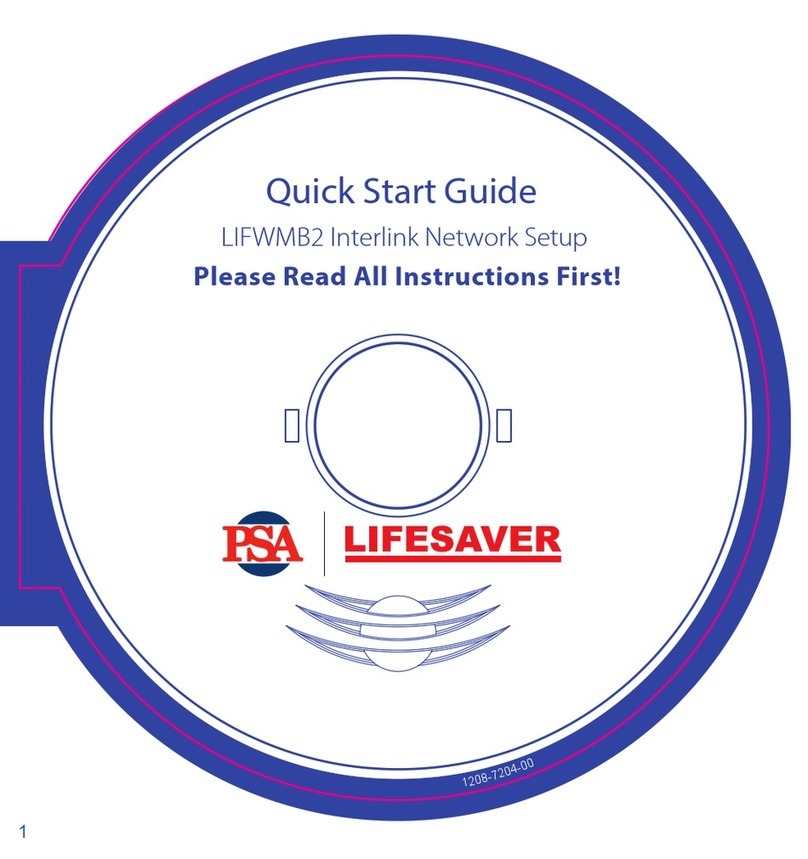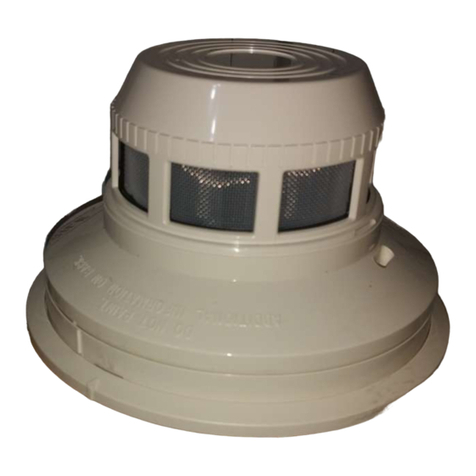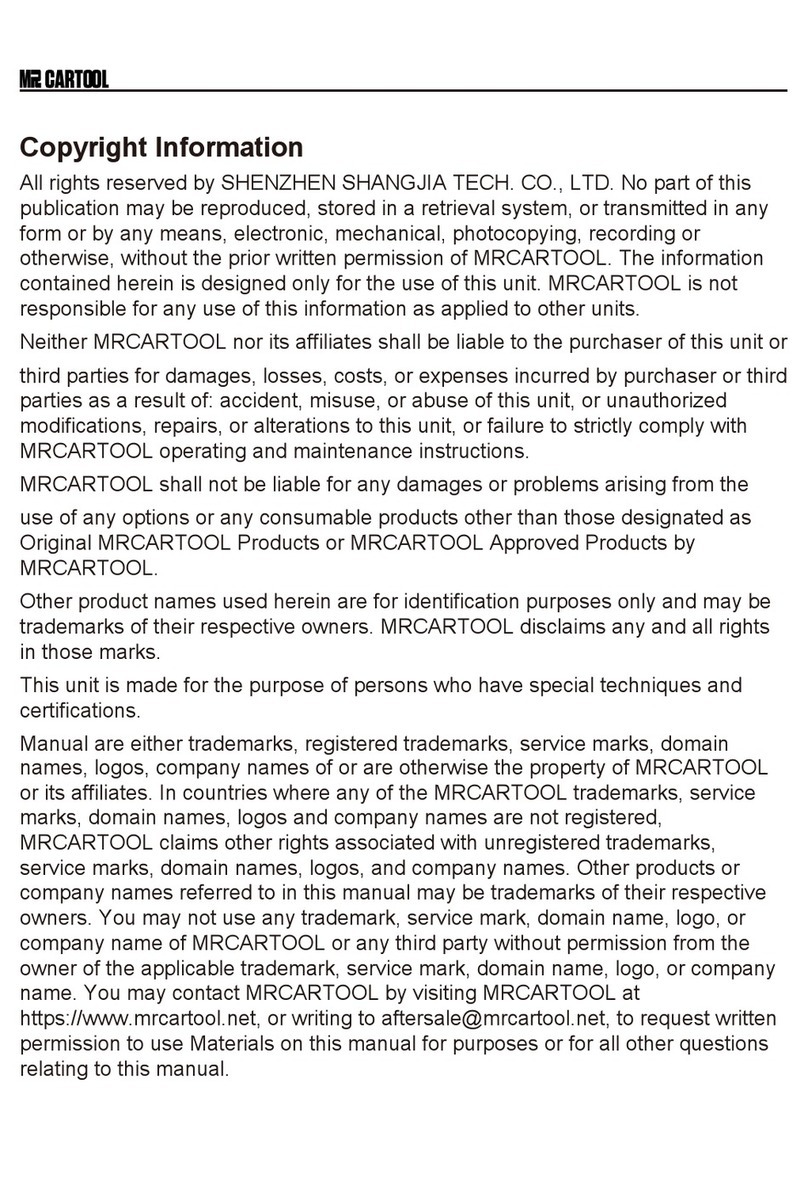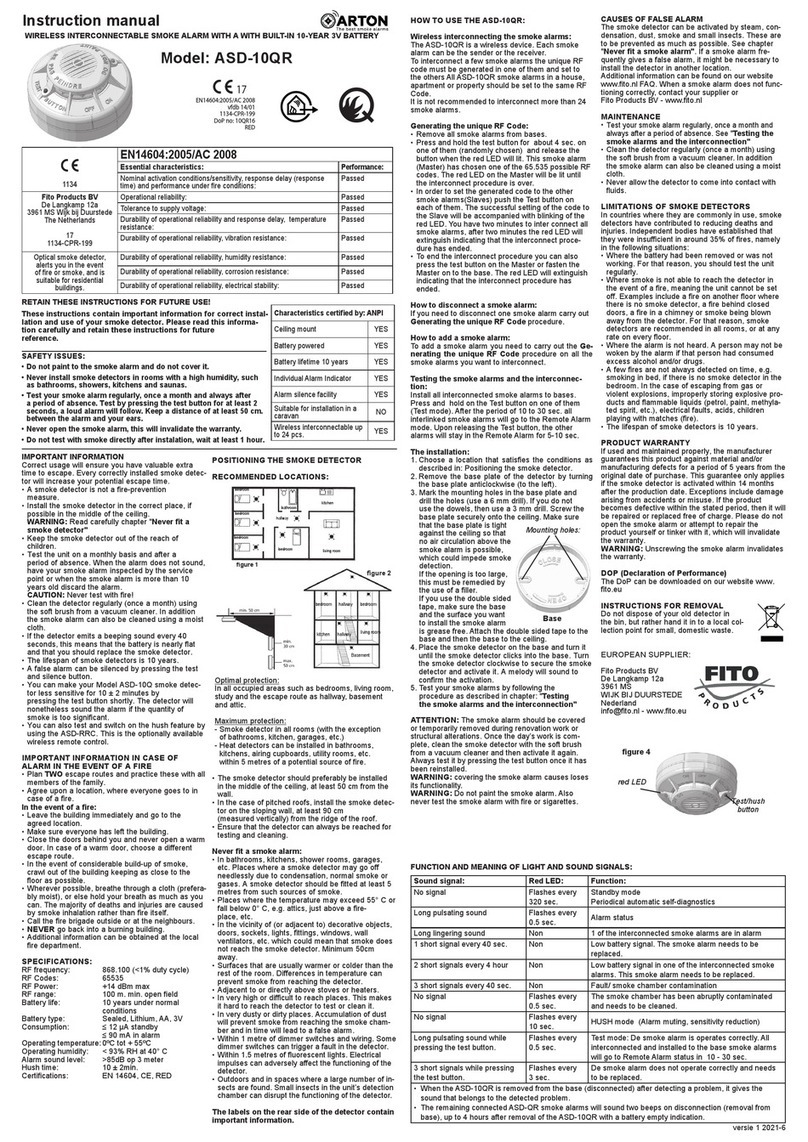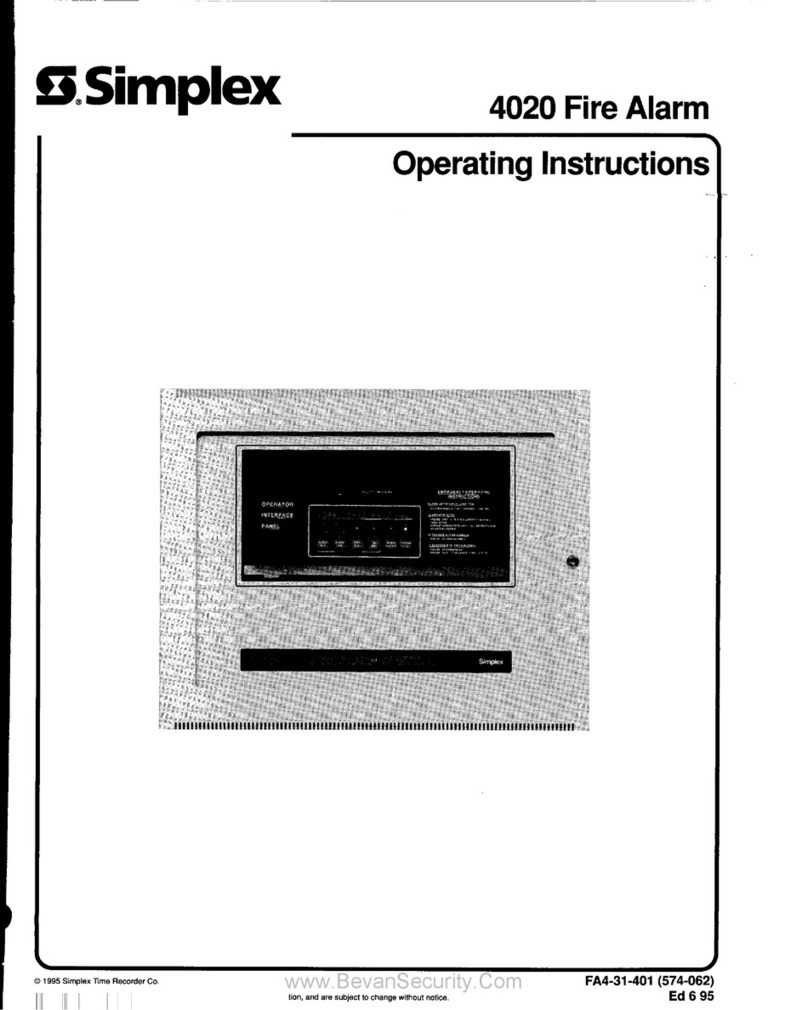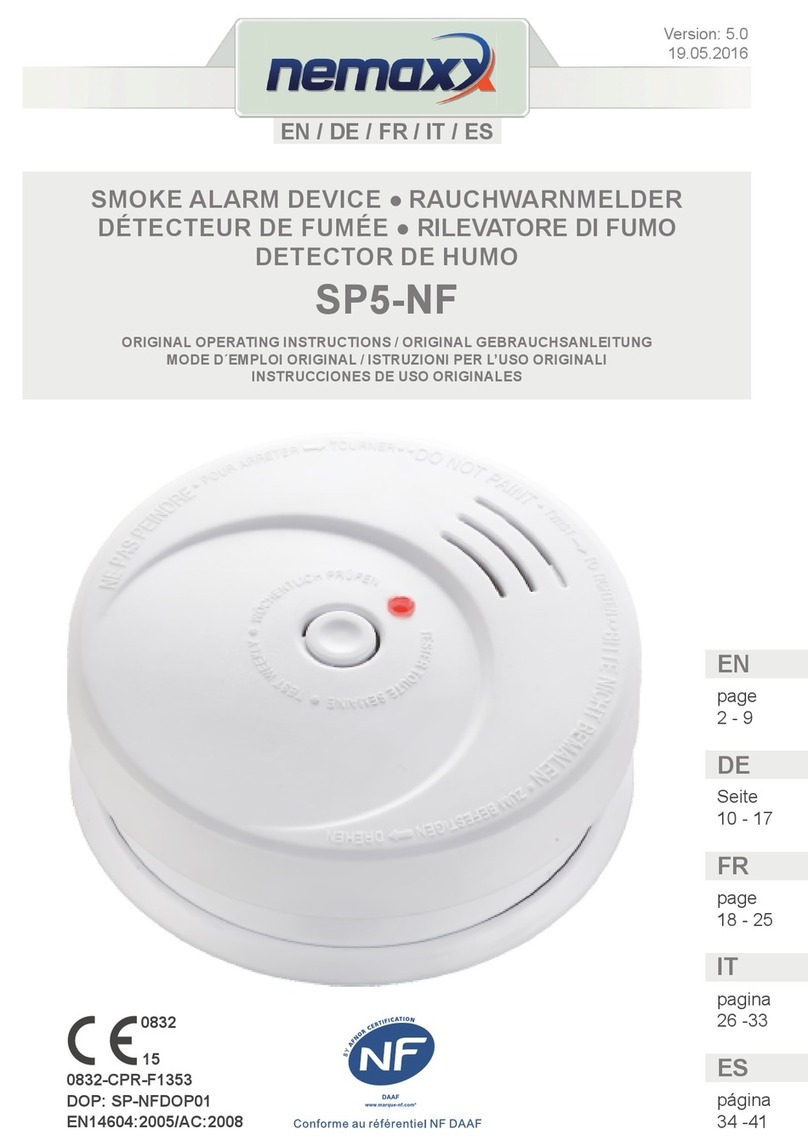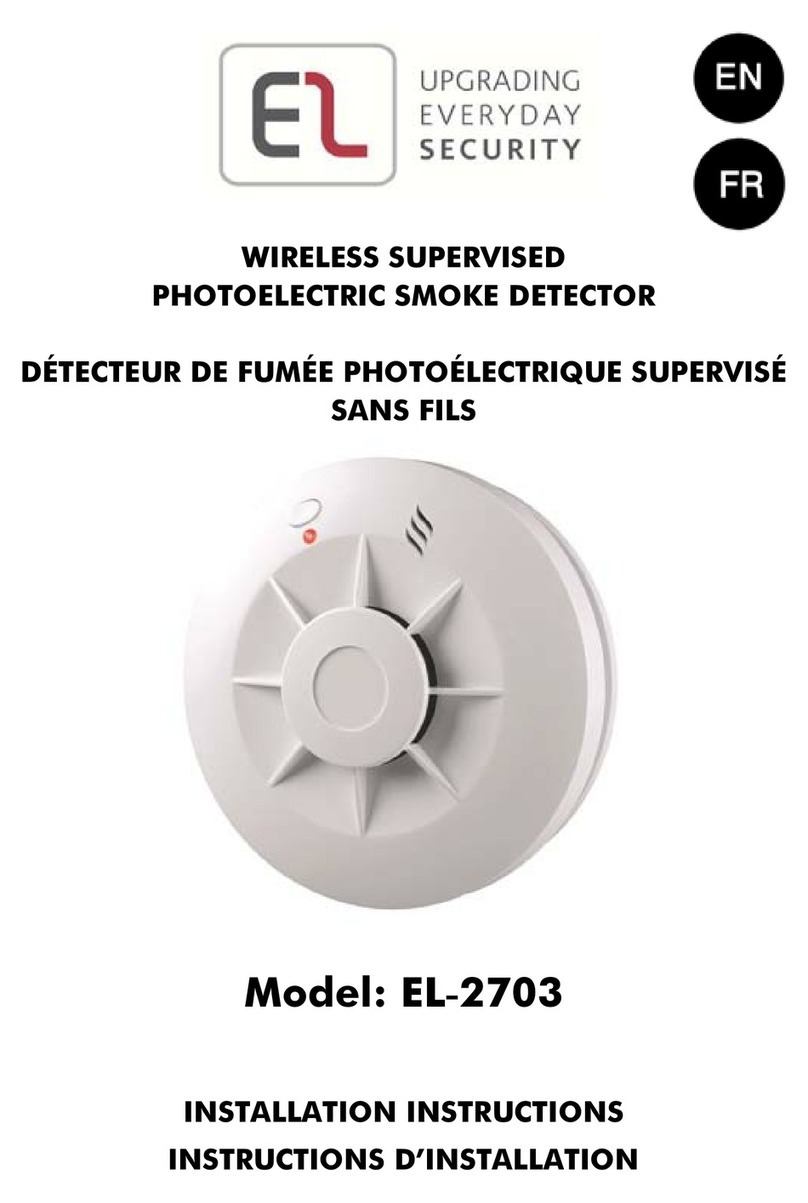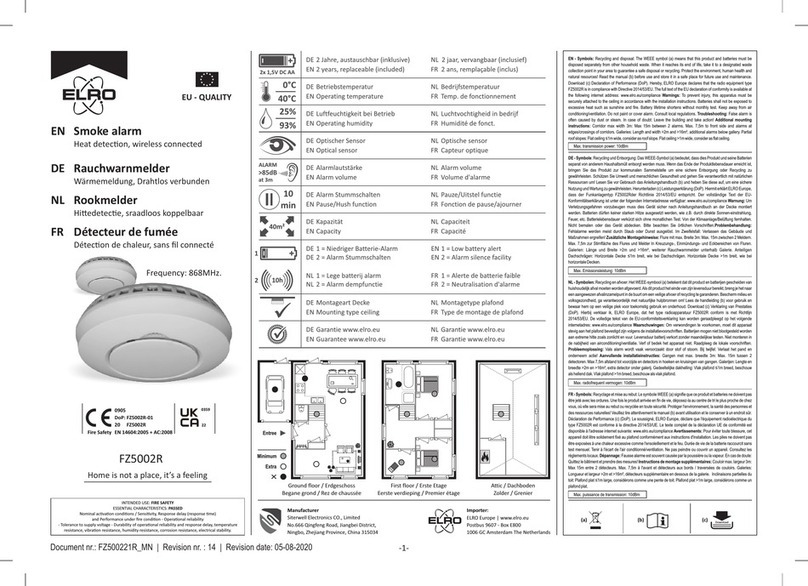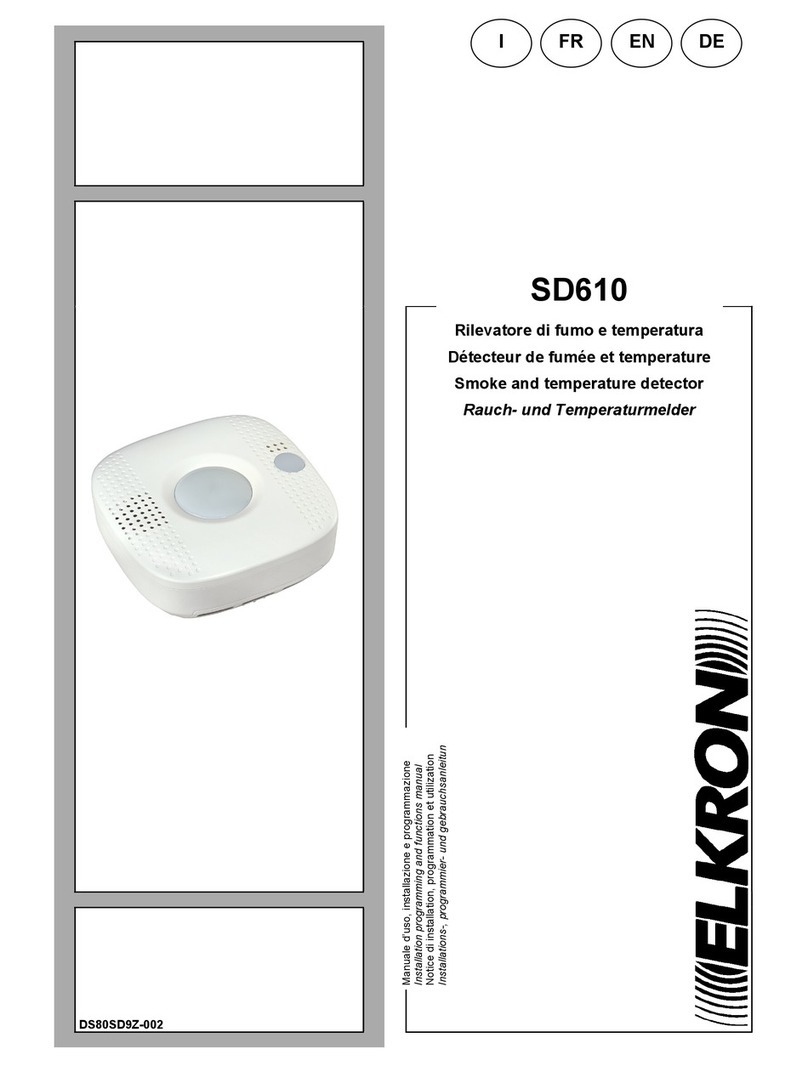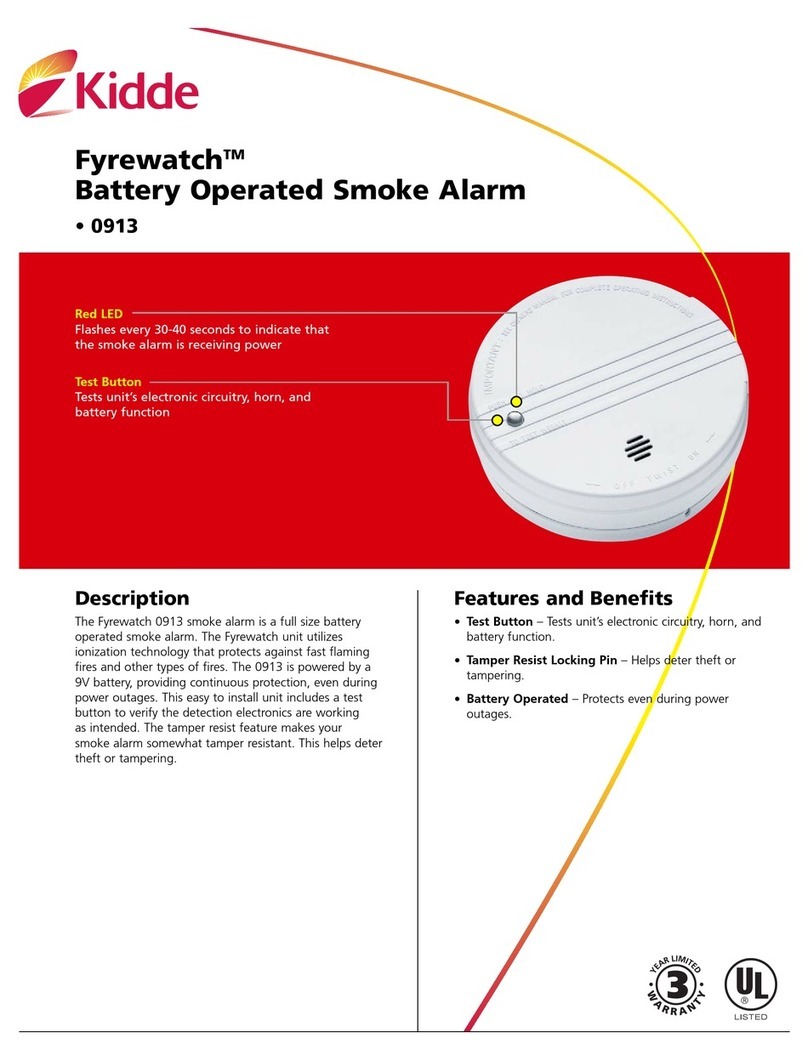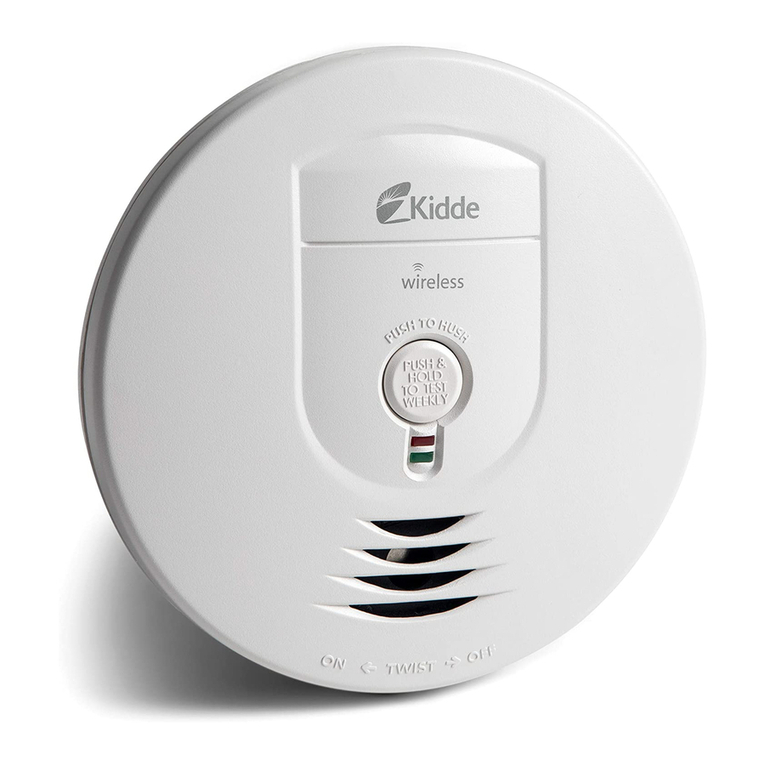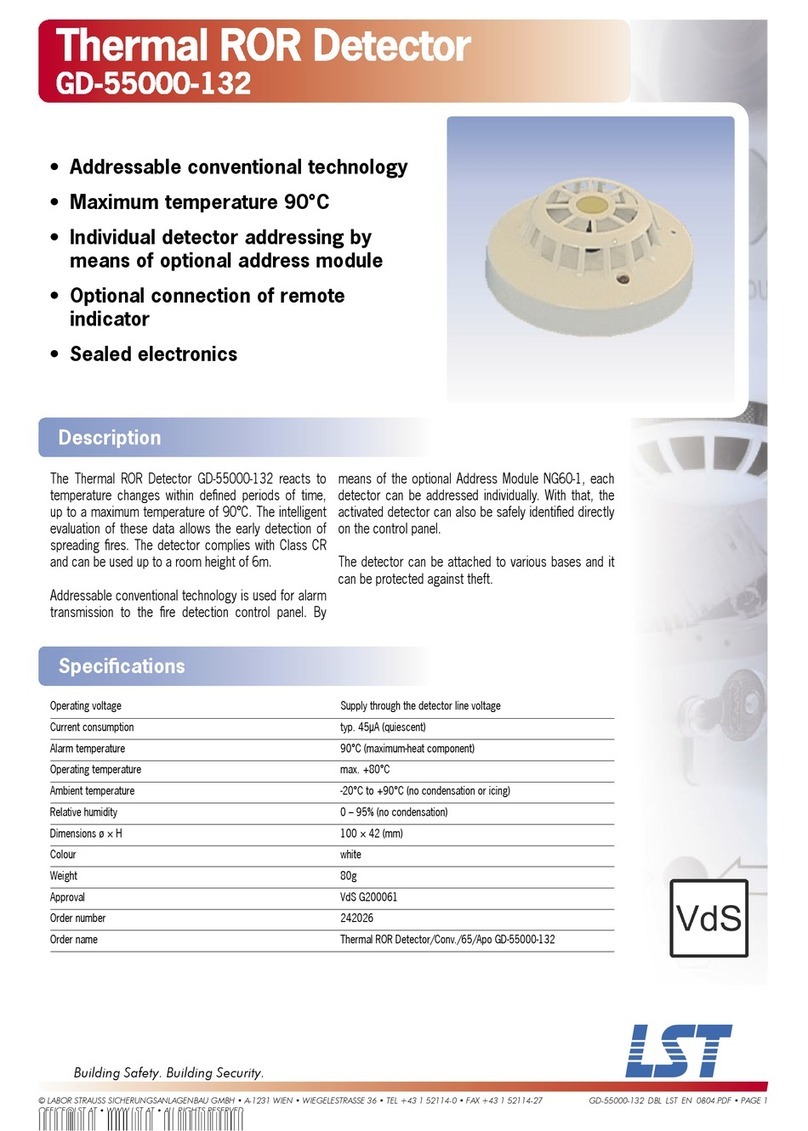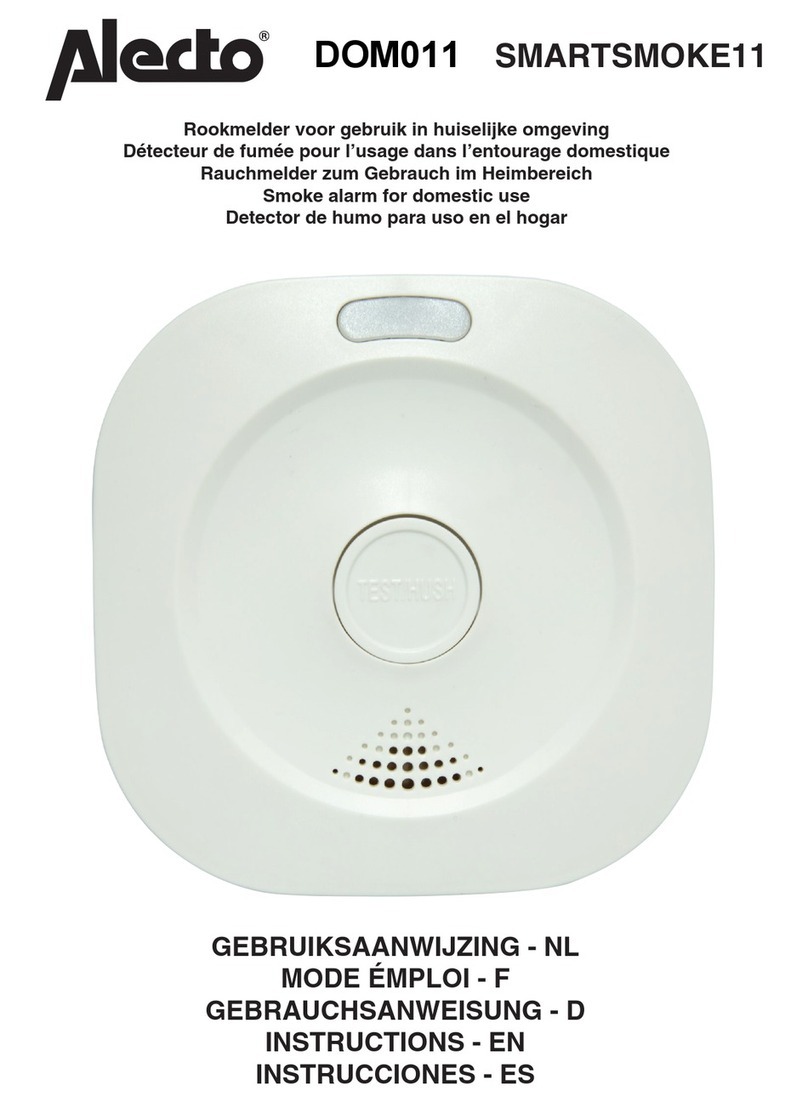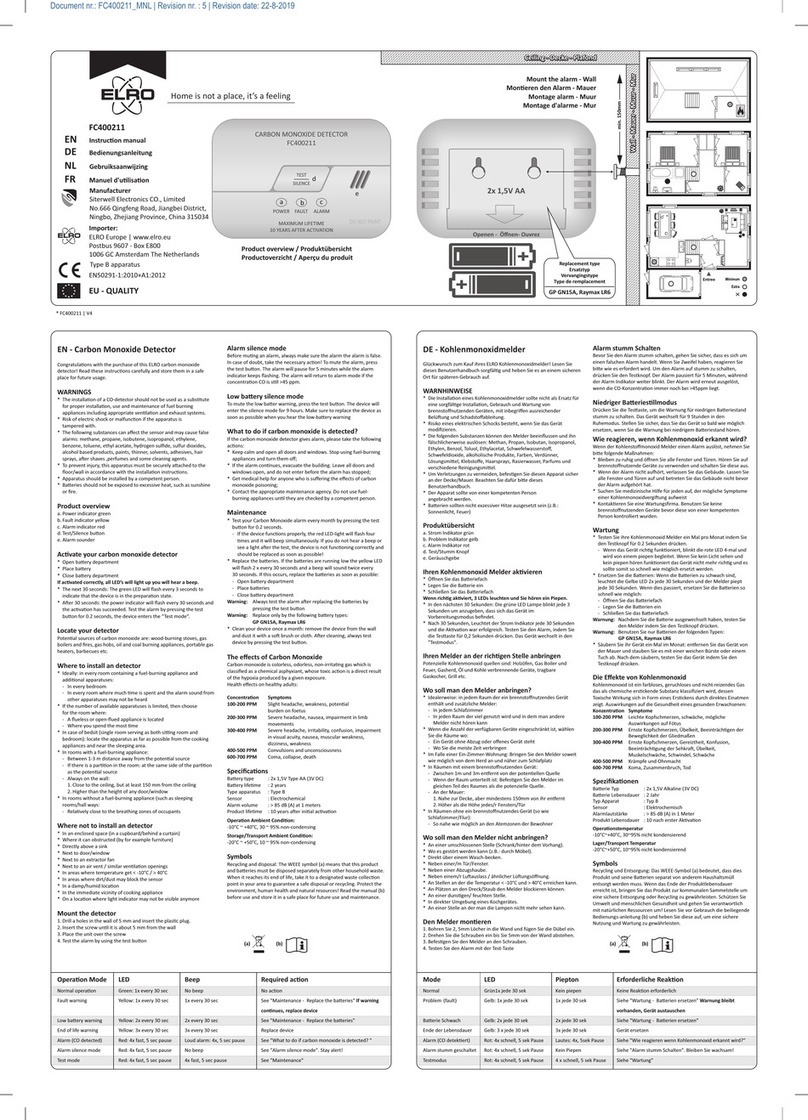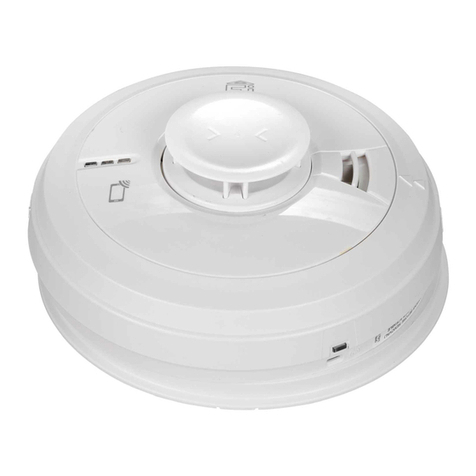PSA LIFESAVER LIFHA240 User manual

1
1002-7217-00
HEAT ALARM
INSTALLATION AND USER MANUAL
Model LIFHA240

2
Thank You for using this LIFHA240 Heat Alarm
THIS HEAT ALARM HAS AN EXPECTED SERVICE LIFE OF TEN YEARS UNDER NORMAL
CONDITIONS. WE RECOMMEND THAT YOU SHOULD REPLACE THE HEAT ALARM AFTER
10 YEARS FROM INSTALLATION DATE TO ENSURE NORMAL OPERATION.
Your LIFHA240 Heat Alarm is designed for use in a residential dwelling.
It is not designed for use in a recreational vehicle (RV) or boat.
Note: Please read this user guide and save the document for future reference and to pass on
to any subsequent owner.
Date Code (on back): ___________________
Date of Purchase: ___________________
Where Purchased: ___________________
Date to Replace: ___________________
Product Support: 1300 772 776
Please record the following information & have
this at hand when you call us.

3
Contents
1. Heat Alarm: What To Do When the Alarm Sounds..........................................................................4
2. Product Features And Specifications ...............................................................................................5
3. Recommended Locations Of alarms .............................................................................................. 7
4. Locations To Avoid .......................................................................................................................11
5. Installation.....................................................................................................................................12
6. Mounting Instructions ...................................................................................................................14
7. Operation and Testing ................................................................................................................. 15
8. Alarm Nuisance And HUSH............................................................................................................17
9. Troubleshooting..............................................................................................................................18
10. Battery Replacement .....................................................................................................................19
11. The Limitations of Heat Alarms .....................................................................................................20
12. Cleaning Your Alarm ....................................................................................................................21
13. Good Safety Habits........................................................................................................................22
14. Repairs and Services ..................................................................................................................... 22
15. Warranty and Liability .................................................................................................................. 23
16. Product warranty registration........................................................................................................ 24

4
1. Heat Alarm: What To Do When the Alarm Sounds
Heat alarm pattern is three long beeps, a 1.5 second pause, and three long beeps repeating.
Alert small children in the home as well as anyone else that might have difficulty recognizing the
importance of the alarm sounding or that might have difficulty leaving the area without help.
Leave immediately by your escape plan. Every second counts, so don’t waste time getting dressed or
picking up valuables.
• When leaving, don’t open any inside door without first feeling its surface. If hot, or if you see
smoke seeping through cracks, don’t open that door! Instead, use your alternate exit. If the inside
of the door is cool, place your shoulder against it, open it slightly and be ready to slam it shut if
heat and smoke rush in.
• If the escape route requires you to go through smoke, stay close to the floor where the air is
cleaner. Crawl if necessary, and breathe shallowly through a cloth, wet if possible.
• Once outside, go to your selected meeting place and make sure everyone is there.
• Call the fire department from your mobile phone outside, or from your neighbour’s home-not from
yours!
• Don’t return to your home until the fire officials say that it is all right to do so.
• There are situations where a smoke and heat alarm may not be effective to protect against fire.
For instance:
a) smoking in bed
b) leaving children home alone
c) cleaning with flammable liquids, such as petrol or methanol.

5
2. Product Features And Specifications
Product Features
The LIFHA240 Heat alarm is powered from a 240V AC supply, and has a DC battery back-up. AC/DC
heat alarms offer added protection in the event of a power failure. Unique power connector prevents
interconnecting with incompatible heat alarms, CO alarms, smoke alarms, or security systems. The heat
alarms can be interconnected with up to 24 other PSA Lifesaver models. Do not connect to any other
type or model of smoke, CO, or heat alarm.
• Hush feature silences unwanted alarms for up to 10 minutes
• Alarm memory identifies when alarm has activated
• Optional use tamper-resistant feature serves as a safeguard against tampering
• The heat alarm will sound a short beep about once every 40 seconds if the battery is low
• Multi-purpose green and red LEDs indicate that the heat alarm is connected to the AC supply,
is working normally, or is in alarm
• Loud alarm sounder – 85 dB
• Test button checks heat alarm operation
WARNING! THIS HEAT ALARM IS NOT DESIGNED AS AN EARLY WARNING TO A FIRE
BECAUSE IT DOES NOT DETECT SMOKE. SEE LIMITATIONS OF THE HEAT ALARM IN SECTION
11 FOR DETAILS.
WARNING! REMOVAL OF HEAT ALARM BATTERY AND DISCONNECTING OR LOSS OF AC
POWER WILL RENDER THIS UNIT INOPERATIVE.
DO NOT TRY TO REPAIR THIS HEAT ALARM YOURSELF.

6
Product Specifications
• Electrical Rating: 240V AC 50HZ, DC battery back up (9V battery ).
• Interconnecting Smoke And Heat Alarms- Up to any combination of 23 other alarm models.
• Temperature Rating: 57 °C.
• Maximum Ambient Temperature Rating: 40°C
• Operating Temperature: 0°C TO 40°C
• Operating Humidity: Up To 93% Humidity (Non-Condensing)
• Recommended coverage : 50m2
• Recommended spacing: 5.3m
• Maximum Distance From Wall: 7.7m
• Maximum Ceiling Height: 6m
• Approve to AS1603.3:2018
Important Information
• Please read these instructions before installing the alarm.
• There are no parts within the heat alarm that should be replaced by the user.
• Disconnecting alarm from the mounting base and/or removing the 9V battery will render this heat
alarm inactive.
• Only wire the heat alarm to 240V~ 50Hz Sine wave current supply.
• Heat alarm has an expected service life of 10 years under normal conditions.
• Replace the heat alarm 10 years after its installation date.

7
3. Recommended Locations Of Alarms
This heat alarm must only be wired to a 240V AC 50Hz sine wave current supply.
Heat alarms give an audible warning when the temperature at the alarm reaches 57°C.
Heat alarms are ideal for kitchens, garages, cellars, boiler rooms, attics and other areas where
there are normally high levels of fumes, smoke or dust which preclude the use of smoke alarms
due to the risk of false alarms. Laws on heat alarms vary from state to state and you should be
aware of what the requirements are in the state you live - for more information please refer
to your local fire emergency services. PSA recommends heat alarms be installed in addition to
legislated smoke alarms in areas where there might be high air circulation or in areas such as
kitchens, bathrooms or garages where smoke alarms would be subject to higher false alarms.
If, however, the design of the dwelling does not comply with modern fire safety standards, or
if factors such as the presence of several young children, elderly occupants or disabled people,
or smokers, the use of portable heaters or solid fuel fires during the night, or the use of electric
blankets, particularly by the elderly, PSA advises that additional detection devices, installed
within rooms, may be necessary.
The most favourable mounting location for a heat alarm is on the ceiling and in the centre of
the room. At this location, the alarm is closest to all areas of the room. EXCEPTION: When the
mounting surface might become considerably warmer or cooler than the room, such as a poorly
insulated ceiling, below an unfinished attic, or an exterior wall. In these cases the alarm should
be mounted on an inside wall.
• If the alarm cannot be located
in the centre of the room, an
off-centre location can be used
on the ceiling. When off-centre
mounting an alarm on the ceiling,
locate it at a minimum of 300mm
from the side wall (FIGURE 2A
and 2B).

8
• Check specific State legislation in your area to ensure smoke and heat alarms are correctly
located according to local laws. Each State or Territory may differ in building codes and
regulations. PSA Products can only recommend the locations.
• Locate an alarm for each separate sleeping area in the immediate vicinity of the bedrooms.
Try to monitor the exit path as the bedrooms are usually farthest from an exit. If more than
one sleeping area exist, locate additional alarms in each sleeping area in the immediate
vicinity.
• Locate additional alarms to MONITOR any stairway because stairways act like chimneys for
smoke and heat.
• Locate at least one alarm on every floor level.
• Locate an alarm in every room where a smoker sleeps.
• Locate an alarm in every room where electrical appliances are operated (i.e. portable heaters
or humidifiers).
• Locate an alarm in every room where someone sleeps with the door closed. The closed door
may prevent an alarm not located in that room from waking the sleeper.
• Smoke, heat and other combustion products rise to the ceiling and spread horizontally.
Mounting the alarm on the ceiling in the center of the room places it closest to all points in
the room. Ceiling mounting is preferred in ordinary residential construction.
• When mounting alarms on the ceiling, locate it at least 300mm away from the side wall and
300mm away from any corner. (see FIGURE 2B).
• When mounting alarms on a wall, use the inside wall. The recommended position is
between 300mm and 500mm off the ceiling. (see FIGURE 2A).
NOTE: The performance of heat alarms mounted on walls is unpredictable and this mounting
position is not recommended when ceiling mounting can be implemented.
• In rooms with open joists or beams,all ceiling mounted alarms shall be located on the
bottom of such beams. (See FIGURE 2C )
• Alarms installed on an open-joist ceiling shall have the smooth ceiling spacing reduced to no
more than half of the listed spacing when measured at right angles to the solid joist.
(See FIGURE 2C)

9
IMPORANT: incorrect orientation of smoke alarm may decrease operational effectiveness
Typical Multiple Floor Installation
Location of alarm
HEAT OR SMOKE ALARMS
AREAS FOR
Apex Of Sloping Ceiling Ceiling / Wall Junction
Single Floor
Smoke alarms for minimum protection
Smoke alarms for additional protection
FIGURE 2C
FIGURE 2A FIGURE 2B

10
Mobile Home Installation
• Modern mobile homes have been designed and insulated to be energy efficient. Install
smoke and heat alarms as recommended (refer to RECOMMENDED LOCATIONS).
• In older mobile homes that are not well insulated compared to present standards,
extreme heat or cold can be transferred from the outside through poorly insulated walls
and roof. This may create a thermal barrier which can prevent smoke from reaching a
smoke alarm mounted on the ceiling. In such units, install smoke and heat alarm on inside
partition between 300mm and 500mm from the ceiling.
• If you are not sure about the insulation in your mobile home, or if you notice the
walls and ceilings are either hot or cold, install alarm on an inside wall. For minimum
protection, install one alarm close to the bedrooms.
• For additional protection, see SINGLE FLOOR PLAN ( see FIGURE 2D )
• Locate an alarm in every room where a smoker sleeps.
NOTE: Test your smoke and heat alarm operation after mobile home vehicle has
been in storage, before each trip and at least once week during use.
SINGLE FLOOR
FIGURE 2D
Smoke alarms for minimum protection
Heat alarms for minimum protection
Smoke alarms for additional protection

11
4. Locations To Avoid
• Do not locate your alarm in front of forced air supply ducts used for heating and air conditioning
and other high air flow areas.
• Do not locate your alarm less than 500mm from the peak of an “A” frame type ceiling.
• Do not locate your alarm in areas where temperatures may fall below 0°C or rise above 40°C,
or in humidity higher than 95% as these conditions may reduce battery life.
• Avoid insect-infested areas.
• Do not locate alarm within 0.9m of the following: the door to a kitchen, the door to a
bathroom containing a tub or shower, ceiling or whole house ventilating fans, or other high
flow areas.
• Avoid locating near fluorescent lights or other electrical equipment. Electronic magnetic
interferences or “noise” may cause nuisance alarms or chirping.
• Near fluorescent lights, including CFL lamps. Electronic “noise” may cause nuisance alarms.
• Heat alarms are not to be used with detector guards unless the combination (alarm and guard)
has been evaluated and found suitable for that purpose.

12
5. Installation
DANGER: ELECTRICAL SHOCK HAZARD. Turn off power at the main fuse box
or circuit breaker by removing the fuse or switching the circuit breaker to the OFF
position and securing it. An all-pole mains switch with a contact separation
of at least 3mm in each pole shall be incorporated in the electrical installation of the
building.
WARNING: THIS HEAT ALARM MUST BE INSTALLED BY QUALIFIED (LICENSED)
ELECTRICIANS ONLY.
Wiring Requirements
• This heat alarm should be installed with an AS/NZS Wiring Rules approved junction box. All
connections must be installed by a qualified electrician and be in accordance with the relevant
requirements of the SAA Wiring Rules AS 3000 Standards.
• The appropriate power source is 240V AC 50Hz continuous single phase sine wave current supplied
from a non-switchable circuit which is not protected by a RCD.
• Heat alarms are not to be used with detector guards unless the combination (alarm and guard) has
been evaluated and found suitable for that purpose.
WARNING: This alarm cannot be operated from power derived from a square wave or modified
square wave inverter. These type of inverters are sometimes used to supply power to the structure in
off grid installations, such as solar or wind derived power sources. These power sources produce high
peak voltages that will damage the alarm.
Wiring instructions for AC harness
CAUTION! TURN OFF THE MAIN POWER TO THE CIRCUIT
BEFORE WIRING THE ALARM.
• For alarms that are used as SINGLE STATION, DO NOT CONNECT THE SWITCH WIRE TO
ANYTHING.

13
• When alarms are interconnected, all interconnected units must be powered from a single circuit.
• A maximum of 24 PSA LIFESAVER devices may be interconnected in a multiple station arrangement.
Note: Use approved listed Australian Standards cable 1.0mm² TPS or larger as required by
local codes.
FIGURE 5 “INTERCONNECT WIRING DIAGRAM”
ALARM HARNESS ------------------------ CONNECTED TO:
RED -------------------------- A (Hot Side of AC Line)
BLACK ----------------------- N (Neutral Side of AC Line)
WHITE ---------------------- SW (Interconnect Lines (Red
Wires) of Other Units in the
Multiple Station Set up)
FIGURE 5
A
N
FUSE OR CIRCUIT BREAKER
RED
WHITE
BLACK
A SW N
RED
WHITE
BLACK
A SW N
RED
WHITE
BLACK
A SW N
RED
WHITE
BLACK
LIFESAVER
INTERCONNECT
SMOKE
ALARM
LIFESAVER
INTERCONNECT
CO
ALARM
LIFESAVER
INTERCONNECT
HEAT
ALARM
LOW
BATTERY
POWER
FLASHING
=ALARM
1Flash
=SERVICE

14
6. Mounting Instructions
CAUTION! THE BATTERY TAMPER BUTTON MUST BE HELD DOWN IN THE BATTERY
COMPARTMENT BY THE BATTERY, TO ENSURE THE BATTERY DOOR WILL CLOSE.
NOTE: PLEASE ENSURE THAT BATTERY IS INSTALLED PRIOR TO MOUNTING OF HEAT ALARM.
A trim ring is provided on the back of the heat alarm. This trim ring is removed by holding the trim ring
and twisting the heat alarm in the direction indicated by the TURN TO REMOVE arrow. The trim ring is
secured to the heat alarm by a trim lever.
CAUTION ! THE COVER IS A SEALED UNIT AND HAS NO SERVICEABLE PARTS! DO NOT
TAMPER.
1. Secure a suitable junction box near the position of the heat alarm, ensure the quick connect cable
length is long enough to reach the junction box for termination to be made.
2. Connect active, neutral and switch line to the heat alarm cable using the terminal connection block
provided. Secure these terminals inside the junction box.
3. Punch out the suitable fixing holes on the trim ring and then
pull the AC connector through the centre of the trim ring.
4. Secure the trim ring to the ceiling using the fixing holes provided.
Plug the AC QUICK CONNECTOR into the back of the unit,
making sure that the locks on the connector snap into place
(see FIGURE 6A.)
5. Insert the 9V battery (back up) into the battery compartment.
If the back up 9V battery is already loaded in the Battery
compartment, pull out the battery pull tab. Ensure the locks
on the AC connector snap firmly into place.
6. Now mount the heat alarm onto the trim ring. Rotate the
heat alarm until the heat alarm snaps firmly into place(see
FIGURE 6B.)
Switch on the AC power and the green AC power ‘ON’
indicator should be lit. The heat alarm is now operating
on mains power.
CONNEC
TOR
SQUEEZE
LOCKING
A
RMS AND PULL
INSTALL
MARKS
REMOVE
FIGURE 6A
FIGURE 6B

15
7. Operation and Testing
OPERATION
The heat alarm is operating once AC power is applied, new battery is installed and testing is
complete. When the heat alarm senses temperatures above 57°C (plus or minus a few degrees),
the horn will sound a loud (85db) pulsating alarm.
RED AND GREEN LED INDICATORS:
This heat alarm features a red and green LED indicator that can be seen through the clear light pipe on
the top of alarm. The LEDs indicate the following:
GREEN
ON – AC power is present.
OFF – AC power is not present.
RED
Red LED blinks once every 5 minutes and 20 seconds
– Mains power is present indicating normal operation.
Red LED blinks once every 10 seconds
– Hush mode activated.
Red LED OFF
– DC power is not present.
Red LED blinks once a second and unit is sounding alarm
– Senses 57°C temperature or greater.
Red LED OFF and unit is sounding alarm
– Another interconnected smoke/heat alarm in the network has
sensed smoke or 57°C temperature and is signalling this alarm.
Red LED is 3 rapid flashes at 40 second interval
– Indicates which alarm has previously detected an alarm
condition
Note: Red LED blinks during Fault, Low Battery or End of Unit Life chirps (see Section 9).

16
TESTING THE HEAT ALARM
Warning: test each heat alarm and smoke alarm to be sure that each is installed correctly
and is operating properly.
Stand at arm’s length from the heat alarm when testing. The alarm sounder is loud to alert you to an
emergency and can be harmful to hearing.
Test the heat alarm weekly and upon returning from holiday, or when the house has been unoccupied
for several days.
Test all heat alarms weekly by doing the following:
1. Check the TEST/HUSH button. If the green LED above the test button is ON, the heat alarm is
receiving AC power.
2. Firmly depress and hold the TEST/HUSH button for at least five (5) seconds. The heat alarm will
sound 3 long beeps, pause, 3 longs beeps, repeating for up to 10 seconds after the TEST/HUSH
button is released. NOTE: If heat alarms are interconnected, all heat and smoke alarms should
sound an alarm within three (3) seconds after any test button is pushed and the tested heat alarm
sounds.
3. If the heat alarm does not sound, please refer to Section 9 Troubleshooting. If this doesn’t work
please contact your electrician.
Warning: If the heat alarm sounds, and the heat alarm is not being tested, the heat alarm
is sensing a temperature of 57°C or above. THE ALARM SOUND REQUIRES YOUR IMMEDIATE
ATTENTION AND ACTION. EVACUATE THE DWELLING IMMEDIATELY!

17
8. Nuisance Alarm And HUSH
Heat alarms respond only to heat. They do not detect smoke. If the alarm does sound, check for fires
first. If a fire is discovered, get out of the house and call the fire brigade. If no fire is present, check to
see if one of the reasons listed in Section 4 may have caused the alarm.
HUSH
The Hush feature will silence the alarm for approximately 10 minutes. After 10 minutes the heat alarm
will revert to normal operation. If the unit still detects a dangerous situation the alarm will sound again.
A rapid rise in temperature will override the Hush Mode Control and cause the unit to sound an alarm.
If interconnected alarms are installed, the unit that detects the high temperature and sounds the alarm
cannot be inadvertently silenced by the TEST/HUSH button of other units. In this case all of the alarms
will continue to sound for as long as a dangerous situation is detected or until the TEST/HUSH button
of the initiating alarm is pressed.
If the alarm does not go into Hush Mode and continues to sound its alarm, the heat in the area is too
high and a dangerous situation may exist – take emergency action.
Warning: Before using the alarm’s Hush feature, fully identify the source of the heat
build up and make sure that the area is safe. To activate control push and release the test/
false alarm control button in the center of the alarm. The alarm will silence immediately and
the red light (LED) will blink approximately every 10 seconds for the next 10 minutes. This
feature is to be used only when a safe condition is known to exist.
ALARM MEMORY FEATURE
This heat alarm has a memory function that will inform you if the alarm has initially sounded. If the
unit has initiated the alarm, the red LED will flash 3 times every 40 seconds. Pressing the test button
will cause the unit to chirp repeatedly and the red LED to flash rapidly. When the button is release the
alarm memory is reset.

18
9. Troubleshooting
PROBLEM SOLUTION
Heat alarm does not sound when tested.
NOTE: Push and hold test button for at
least five (5) seconds while testing
1. Check that AC power is turned on.
2. Turn off power. Remove heat alarm from mounting
plate and:
a. check that connector plug is securely attached.
b. Check that Section 10 Battery is installed
correctly
3. Clean heat alarm.
Heat alarm beeps once every 40 seconds Turn off AC power, replace battery and Clean alarm.
See “Section 10 Battery Replacement”and
“Section 11 Cleaning Your Alarm”
Heat alarm sounds unwanted alarms. 1. Hire an electrician to move heat alarm to a new
location. See “Section 3 Recommended
Locations” and “Section 4 Locations to Avoid”
Interconnected heat alarms do not sound
when system is tested.
1. Press and hold button for at least five seconds after
the first unit sounds.
2. Turn off AC power or circuit breaker and check the
interconnect wiring.
See “Section 5 Wiring Instructions.”
3 chirps every
40 seconds
1. Before 10 years of operation: unit is in fault mode.
Contact customer service.
2. After 10 years of operation: end of life warning.
Alarm must be replaced (REPLACE IMMEDIATELY!)

19
10. Battery Replacement
To replace the battery, remove the alarm from the trim ring by rotating the alarm in the direction of the
“OFF” arrow on the cover (See Section 6, FIGURE 6B). To disconnect the AC power harness, squeeze
the locking arms on the sides of the Quick Connector while pulling the connector away from the bottom
of the alarm (see Section 6, FIGURE 6A).
To remove the alarm when tamper resist tab is engaged, press down on the tamper resist tab, and rotate
the alarm to remove it from mounting trim ring. (see FIGURE 12A). Note: To make heat alarm tamper
resistant, a tamper resist feature has been provided. Using the tamper resist feature will help deter
children and others from removing the alam.
Battery Installation and replacement:
To replace or install the battery you must first remove the alarm from the trim ring by following the
ALARM REMOVAL instructions at the beginning of this section. After the alarm has been removed you
can remove the AC power harness and open the battery door and install or replace the battery. Install the
battery to the battery terminal clip of the heat alarm. When installing the battery, press the battery lever
down into the battery compartment and install the battery. (see FIGURE 12B ).
Caution ! If the battery compartment is closed without a battery, the red battery tamper will prevent the
heat alarm from attaching to the trim ring.
NOTE: Constant exposure to extreme temperatures and humidity may affect battery life.
Replace battery at least once a year or immediately when the low battery signal sounds once every 40 seconds,
even though the heat alarm is receiving AC power.
Whenever the battery is replaced, test heat alarm using the test facility.
Use Only The Following 9Volt Batteries For Heat Alarm Replacement:
Alkaline type: ENERGIZER 522; DURACELL MN1604 or MX1604
Lithium type: FDK CP-V9Ju; ULTRALIFE U9VL-J
Note: regular weekly testing is recommended
Warning! Use only the batteries specified. Use of different batteries may have a detrimental effect
on the alarm. Exposure to temperature extremes and / or high humidity may reduce battery life.
.
FIGURE 12A FIGURE 12B
Press down
the tamper resist tab

20
11. The Limitations of Heat Alarms
Warning! Heat alarms are not designed to protect life safety against fire and smoke.
In most fires, hazardous levels of toxic gases, smoke and heat can build up before a heat
alarm will operate. In cases where life safety is an issue, heat alarms should only be used
to provide an added source of information and as a supplement to the smoke alarm
installation. Heat alarms do not always detect fires, the fire may be a slow smoldering
(smoke producing) low heat producing type, the fire may be in a different room than the
alarm, or the heat from the fire may bypass the alarm. This alarm will not detect smoke,
gases or flames.
Heat alarms cannot provide an alarm if heat does not reach the alarm. Therefore, heat alarms may not
sense fires starting in chimneys, walls, on roofs, on the other side of a closed door or on a different
floor. If the alarm is located outside the bedroom or on a different floor, it may not wake up a sound
sleeper. The use of alcohol or drugs may also impair ones ability to hear the alarm. For maximum
protection heat alarms should only be used as a supplement to smoke alarms. Smoke alarms should be
installed in each sleeping area on every level of a home and be interconnected with each other and the
heat alarms. Although heat alarms when combined with smoke alarms, can help save lives by providing
an early warning of a fire, they are not a substitute for an insurance policy. Home owners and renters
should have adequate insurance to protect their lives and property.
This heat alarm has an expected service life of 10 years under normal conditions.
We recommend that you should replace the heat alarm after 10 years from installation date to ensure
normal operation.
PSA recommend to write the replacement date on th supplied “ Replace By” label and apply on the
unit.
Table of contents
Other PSA Smoke Alarm manuals

PSA
PSA LIFESAVER LIF10YPEW User manual

PSA
PSA LIFESAVER LIFPE10LP User manual

PSA
PSA Lifesaver HA240 User manual
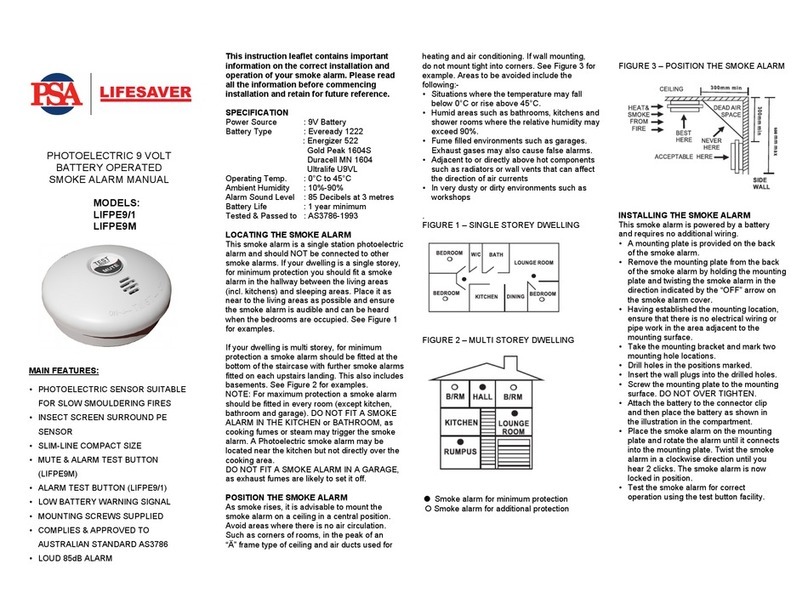
PSA
PSA LIFESAVER LIFPE9/1 User manual
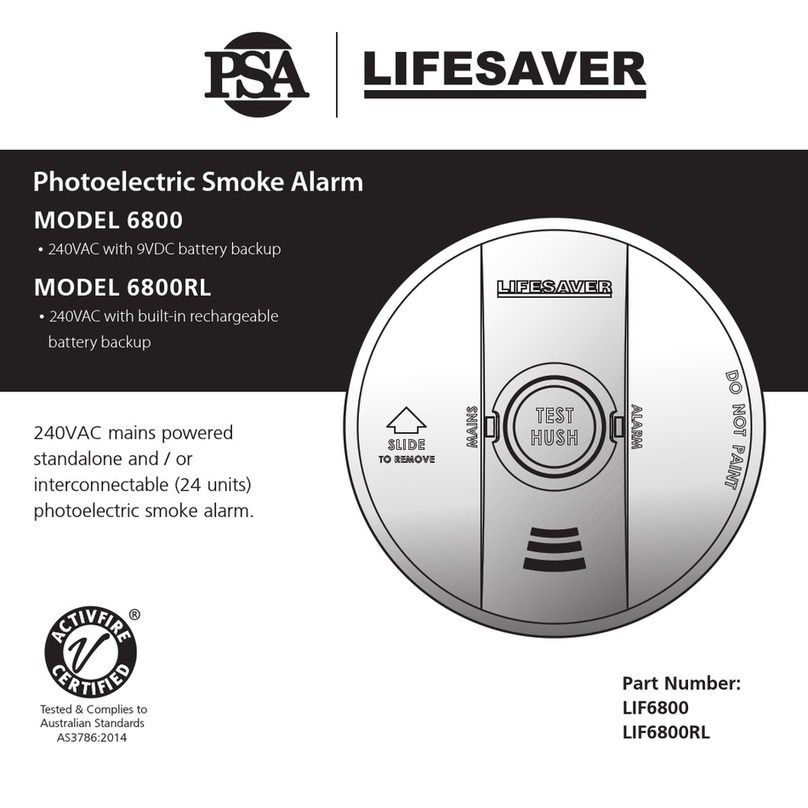
PSA
PSA Lifesaver 6800RL User manual
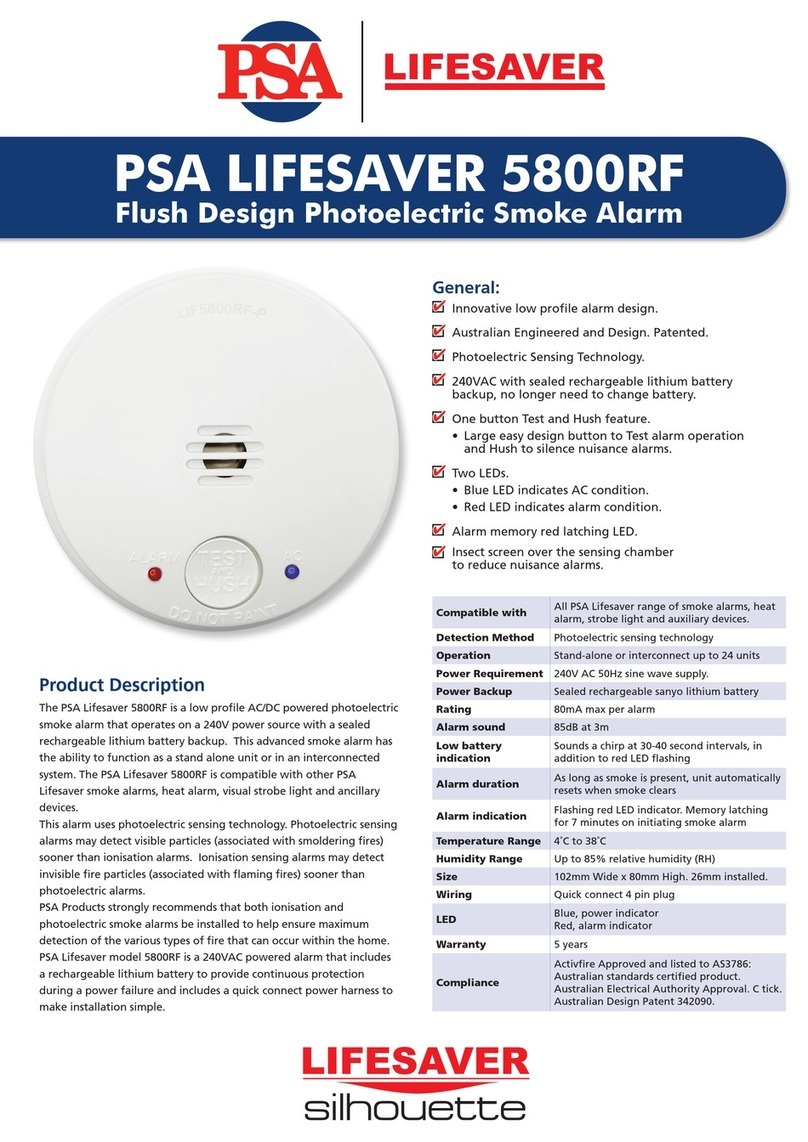
PSA
PSA LIFESAVER 5800RF User manual
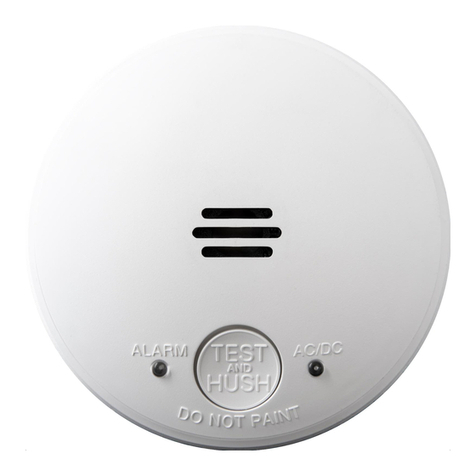
PSA
PSA LIFESAVER LIF5800ACF User manual
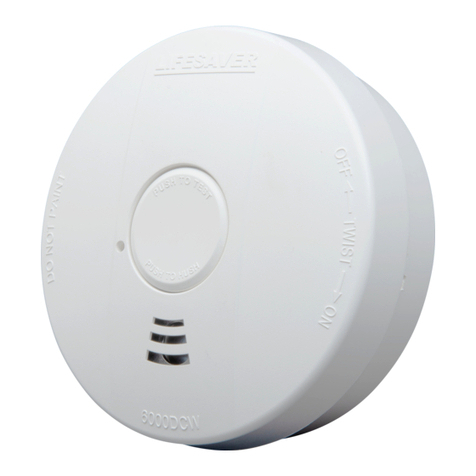
PSA
PSA LIFESAVER 6000DCW User manual
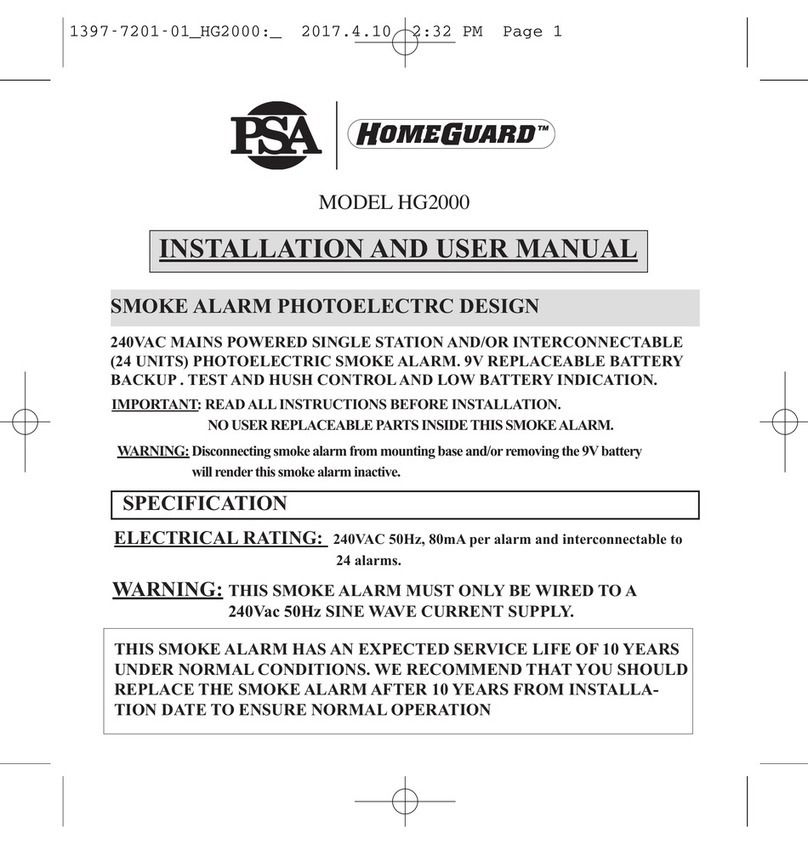
PSA
PSA Homeguard HG2000 User manual
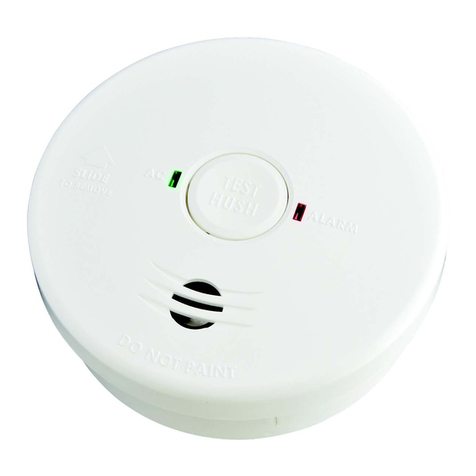
PSA
PSA LIF5800/2 User manual
